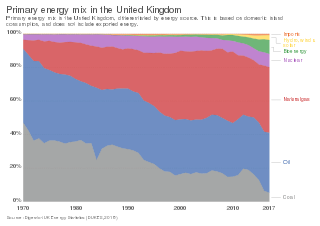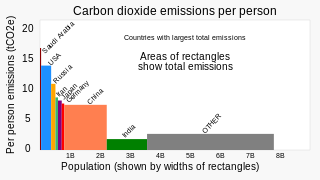Related Research Articles
Environmental finance is a field within finance that employs market-based environmental policy instruments to improve the ecological impact of investment strategies. The primary objective of environmental finance is to regress the negative impacts of climate change through pricing and trading schemes. The field of environmental finance was established in response to the poor management of economic crises by government bodies globally. Environmental finance aims to reallocate a businesses resources to improve the sustainability of investments whilst also retaining profit margins.

Green building refers to both a structure and the application of processes that are environmentally responsible and resource-efficient throughout a building's life-cycle: from planning to design, construction, operation, maintenance, renovation, and demolition. This requires close cooperation of the contractor, the architects, the engineers, and the client at all project stages. The Green Building practice expands and complements the classical building design concerns of economy, utility, durability, and comfort. Green building also refers to saving resources to the maximum extent, including energy saving, land saving, water saving, material saving, etc., during the whole life cycle of the building, protecting the environment and reducing pollution, providing people with healthy, comfortable and efficient use of space, and being in harmony with nature. Buildings that live in harmony; green building technology focuses on low consumption, high efficiency, economy, environmental protection, integration and optimization.’
The Ministry for the Environment is the public service department of New Zealand charged with advising the New Zealand Government on policies and issues affecting the environment, in addition to the relevant environmental laws and standards. The Environment Act 1986 is the statute that establishes the Ministry.

Building information modeling (BIM) is a process involving the generation and management of digital representations of the physical and functional characteristics of buildings and other physical assets. BIM is supported by various tools, technologies and contracts. Building information models (BIMs) are computer files which can be extracted, exchanged or networked to support decision-making regarding a built asset. BIM software is used by individuals, businesses and government agencies who plan, design, construct, operate and maintain buildings and diverse physical infrastructures, such as water, refuse, electricity, gas, communication utilities, roads, railways, bridges, ports and tunnels.

In 2022, 79.6% of Taiwan's electricity generation came from fossil fuels, 9.1% from nuclear, 8.6% from renewables, and 1.2% from hydro. Taiwan relies on imports for almost 98% of its energy, which leaves the island's energy supply vulnerable to external disruption. In order to reduce this dependence, the Ministry of Economic Affairs' Bureau of Energy has been actively promoting energy research at several universities since the 1990s.

The energy policy of the United Kingdom refers to the United Kingdom's efforts towards reducing energy intensity, reducing energy poverty, and maintaining energy supply reliability. The United Kingdom has had success in this, though energy intensity remains high. There is an ambitious goal to reduce carbon dioxide emissions in future years, but it is unclear whether the programmes in place are sufficient to achieve this objective. Regarding energy self-sufficiency, UK policy does not address this issue, other than to concede historic energy security is currently ceasing to exist.
The Energy Technologies Institute (ETI) was a public-private partnership between global energy and engineering companies and the UK Government that was established in the United Kingdom in 2007. The government set up the ETI following an announcement in the 2006 budget speech. The purpose of the ETI is to “accelerate the development, demonstration and eventual commercial deployment of a focused portfolio of energy technologies, which will increase energy efficiency, reduce greenhouse gas emissions and help achieve energy and climate change goals”. The institute works with a range of academic and commercial bodies.
The Climate Change Committee (CCC), originally named the Committee on Climate Change, is an independent non-departmental public body, formed under the Climate Change Act (2008) to advise the United Kingdom and devolved Governments and Parliaments on tackling and preparing for climate change. The Committee provides advice on setting carbon budgets, and reports regularly to the Parliaments and Assemblies on the progress made in reducing greenhouse gas emissions. Notably, in 2019 the CCC recommended the adoption of a target of net zero greenhouse gas emissions by the United Kingdom by 2050. On 27 June 2019 the British Parliament amended the Climate Change Act (2008) to include a commitment to net zero emissions by 2050. The CCC also advises and comments on the UK's progress on climate change adaptation through updates to Parliament.

The United States produced 5.2 billion metric tons of carbon dioxide equivalent greenhouse gas (GHG) emissions in 2020, the second largest in the world after greenhouse gas emissions by China and among the countries with the highest greenhouse gas emissions per person. In 2019 China is estimated to have emitted 27% of world GHG, followed by the United States with 11%, then India with 6.6%. In total the United States has emitted a quarter of world GHG, more than any other country. Annual emissions are over 15 tons per person and, amongst the top eight emitters, is the highest country by greenhouse gas emissions per person.

Climate change is having major effects on the Chinese economy, society and the environment. China is the largest emitter of carbon dioxide, through an energy infrastructure heavily focused on coal. Other industries, such as a burgeoning construction industry and industrial manufacturing, contribute heavily to carbon emissions. However, like other developing countries, on a per-capita basis, China's carbon emissions are considerably less than countries like the United States. It has also been noted that higher-income countries have outsourced emissions-intensive industries to China. On the basis of cumulative CO2 emissions measured from 1751 through to 2017, China is responsible for 13% globally and about half of the United States' cumulative emissions. China is now the world's largest polluter and in 2023 recorded its hottest year on record with an average temperature of 10.7 C.

Greenhouse gas emissions by Australia totalled 533 million tonnes CO2-equivalent based on greenhouse gas national inventory report data for 2019; representing per capita CO2e emissions of 21 tons, three times the global average. Coal was responsible for 30% of emissions. The national Greenhouse Gas Inventory estimates for the year to March 2021 were 494.2 million tonnes, which is 27.8 million tonnes, or 5.3%, lower than the previous year. It is 20.8% lower than in 2005. According to the government, the result reflects the decrease in transport emissions due to COVID-19 pandemic restrictions, reduced fugitive emissions, and reductions in emissions from electricity; however, there were increased greenhouse gas emissions from the land and agriculture sectors.
The climate change policy of the United States has major impacts on global climate change and global climate change mitigation. This is because the United States is the second largest emitter of greenhouse gasses in the world after China, and is among the countries with the highest greenhouse gas emissions per person in the world. Cumulatively, the United States has emitted over a trillion metric tons of greenhouse gases, more than any country in the world.
Margo T. Oge is an American engineer and environmental regulator who served as the director of the Environmental Protection Agency's Office of Radiation and Indoor Air from 1990 to 1994 and director of the Office of Transportation and Air Quality from 1994 to 2012. Beginning in 2009, Oge lead the EPA team that authored the 2010-2016 and the 2017-2025 Light-Duty Vehicle Greenhouse Gas Emissions Standards. By 2025, these rules require automakers to halve the greenhouse gas emissions of cars and light duty trucks while doubling fuel economy. These rules were the US federal government's first regulatory actions to reduce greenhouse gases.
South Korea's Emissions Trading Scheme (KETS) is the second largest in scale after the European Union Emission Trading Scheme and was launched on January 1, 2015. South Korea is the second country in Asia to initiate a nationwide carbon market after Kazakhstan. Complying to the country's pledge made at the Copenhagen Accord of 2009, the South Korean government aims to reduce its greenhouse gas (GHG) emissions by 30% below its business as usual scenario by 2020. They have officially employed the cap-and-trade system and the operation applies to over 525 companies which are accountable for approximately 68% of the nation's GHG output. The operation is divided up into three periods. The first and second phases consist of three years each, 2015 to 2017 and 2018 to 2020. The final phase will spread out over the next five years from 2021 to 2025.

The San Diego Climate Action Plan was adopted by the city of San Diego in December 2015. It is a local climate action plan whose rules are defined by the California global warming Solutions Act of 2006, with the goal of reducing greenhouse gas emissions. Through this plan, the city initially set goals of eliminating half of all greenhouse emissions and sourcing all energy from renewable sources by the year 2035. With a coalition of business owners, environmental advocates, and community leaders, Mayor Kevin Faulconer approved the Climate Action Plan. The Climate Action Plan consists of several policies to ensure the economic and environmental growth of the city of San Diego. It was referred to in The San Diego Union-Tribune as "the most aggressive climate action plan in California."
Transforming Infrastructure Performance is a British government report on the UK construction industry issued by the Infrastructure and Projects Authority in December 2017. Its aim was to improve productivity in the sector and make savings of £15 billion per year. It proposed to do this by increasing innovations like off-site construction and new digital technology, improving government procurement procedures, and improving integration and collaboration. It was seen as a welcome initiative by the industry, and early implementation of its aims has been incorporated into the water industry's 2019 price review.

China's greenhouse gas emissions are the largest of any country in the world both in production and consumption terms, and stem mainly from coal burning, including coal power, coal mining, and blast furnaces producing iron and steel. When measuring production-based emissions, China emitted over 14 gigatonnes (Gt) CO2eq of greenhouse gases in 2019, 27% of the world total. When measuring in consumption-based terms, which adds emissions associated with imported goods and extracts those associated with exported goods, China accounts for 13 gigatonnes (Gt) or 25% of global emissions. According to the Carbon Majors Database, Chinese state coal production alone accounts for 14% of historic global emissions.

Climate change in South Africa is leading to increased temperatures and rainfall variability. Evidence shows that extreme weather events are becoming more prominent due to climate change. This is a critical concern for South Africans as climate change will affect the overall status and wellbeing of the country, for example with regards to water resources. Just like many other parts of the world, climate research showed that the real challenge in South Africa was more related to environmental issues rather than developmental ones. The most severe effect will be targeting the water supply, which has huge effects on the agriculture sector. Speedy environmental changes are resulting in clear effects on the community and environmental level in different ways and aspects, starting with air quality, to temperature and weather patterns, reaching out to food security and disease burden.

Climate change in Nigeria is evident from temperature increase, rainfall variability. It is also reflected in drought, desertification, rising sea levels, erosion, floods, thunderstorms, bush fires, landslides, land degradation, more frequent, extreme weather conditions and loss of biodiversity. All of which continues to negatively affect human and animal life and also the ecosystems in Nigeria. Although, depending on the location, regions experience climate change with significant higher temperatures during the dry seasons while rainfalls during rainy seasons help keep the temperature at milder levels. The effects of climate change prompted the World Meteorological Organization, in its 40th Executive Council 1988, to establish a new international scientific assessment panel to be called the International Panel on Climate Change (IPCC). The 2007 IPCC's fourth and final Assessment Report (AR4) revealed that there is a considerable threat of climate change that requires urgent global attention. The report further attributed the present global warming to largely anthropogenic practices. The Earth is almost at a point of no return as it faces environmental threats which include atmospheric and marine pollution, global warming, ozone depletion, the dangers of pollution by nuclear and other hazardous substances, and the extinction of various wildlife species.

The Initial IMO Strategy on the reduction of GHG emissions from ships, or Initial IMO GHG Strategy, is the framework through which the International Maritime Organization (IMO) aims to reduce greenhouse gas (GHG) emissions from international maritime shipping. GHG emissions from shipping are about 3% of total GHG emissions, and under this strategy the IMO envisions their elimination within this century. However many companies and organizations say shipping should be decarbonized by 2050.
References
- 1 2 3 4 5 6 "Construction 2025" (PDF). HM Government. Retrieved 10 December 2017.
- 1 2 3 Kemp, Daniel (26 June 2014). "Construction 2025 one year on: what next?". Construction News. Retrieved 10 December 2017.
- ↑ Blundell, Steph (5 October 2017). "BRE unites sector to deliver the Construction 2025 strategy | Planning & Building Control Today". Planning & Building Control Today. Retrieved 10 December 2017.
- ↑ Prior, Grant (4 July 2013). "Skanska beats Google in best places to work rankings". Construction Enquirer. Retrieved 10 December 2017.
- ↑ Mann, Will (24 October 2016). "CSCS brings sector up to speed". Construction News. Retrieved 10 December 2017.
- ↑ Morby, Aaron (14 January 2015). "Industry backs radical move towards single skills card". Construction Enquirer. Retrieved 10 December 2017.
- ↑ "FAQs". bim-level2.org. Retrieved 10 December 2017.
- ↑ "Government Construction Strategy: 2016-2020". British Government.